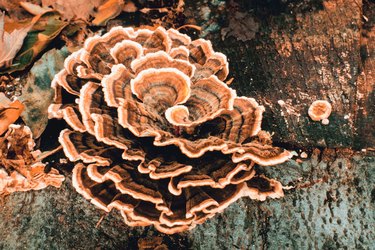
Maitake, Japanese for "dancing mushroom," grows wild in forests, usually springing from the dead roots of trees, such as oak. Maitake clusters reach 30 pounds or more, and their flared gray to brown clusters resemble the fluffed feathers of a sitting hen, hence their English nickname, "hen of the woods."
Eating Raw Maitake
Video of the Day
It's perfectly safe to eat maitake raw. Young maitake are tender throughout their leaf-like lobes and bodies, and you can consume all of them. As they age, maitake becomes tough and fibrous, and only the uppermost lobes remain soft and readily edible. Maitake have a woodsy, spicy taste. Crumble and sprinkle them into salads. Dry or freeze unused portions and add them to soups or steep them in hot water to make maitake tea.
Video of the Day
Nutritional and Medicinal Value of Maitake
Maitake are low in fat and cholesterol, rich in B vitamins, potassium, fiber and complex sugars. Early animal studies imply that maitake extract may stimulate immune function, has anti-tumor effects, lowers blood sugar levels and improves insulin. A 2010 Japanese study suggests maitake potentially induces healthy ovulation in women with insulin-stressed fertility problems. Maitake figures prominently within traditional Chinese folk medicine and is revered for its ability to bolster circulation and lower blood pressure.
Wild Versus Cultivated Maitake
To cultivate maitake at home, purchase ready-to-grow maitake kits. After the maitake kit fruits for the first time, bury it in dirt. In temperate weather zones the fungus continues to yield clusters, especially in the summer to early fall. Cultivated clusters seldom grow to more than a few pounds. Wild maitake clusters occasionally grow to 30 or more pounds, a perk for those who treasure maitake and use it for multiple purposes.
Storing and Using Maitake
Mushrooms are highly perishable and begin to degrade soon after harvesting. Wrap them in moist paper towels and plastic wrap. Make holes in the plastic wrap to allow air circulation. Check the paper towels periodically and moisten them if they begin to dry out. Maitake keep for up to two years when frozen. Cut into desired portion sizes and store them in an airtight container or a sealable freezer bag. To dry maitake, place slices in a dehydrator set at 125 degrees Fahrenheit or in your oven set at the lowest temperature. The average drying time is approximately four hours.
- The Huffington Post: Maitake: The Magnificent 'Dancing' Mushroom
- Fresh Mushrooms: Maitake Mushroom
- West Virginia Division of Natural Resources: Mountain State Flora: Hen of the Woods
- National Center for Biotechnology Information: Maitake Mushroom Induces Ovulation
- Susan G. Komen: Maitake Mushroom
- Humane Living: Munching on Maitakes
- The Washington Post: Maitake: Chicken of the Tree